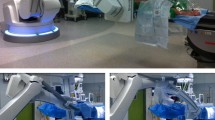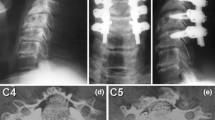Abstract
Purpose
Cadaveric studies have discouraged the use of cervical pedicle screws (CPS) with high misplacement rates. However, the clinical results show minimal screw-related complications and have highlighted the advantages of using CPS. We introduce “acceptable errors classification” in the placement of cervical pedicle screws to bridge the gap between the high radiological perforation rates and low clinical complications.
Methods
Ninety-nine patients with average age of 49 years were operated between December 2011 and June 2017 using CPS. Sixty-one patients had trauma, 33 had CSM, 3 had tumors and 2 patients had fracture with ankylosing spondylitis. The screws were inserted using the medial cortical pedicle screw technique. Axial and sagittal CT reconstructed images along the axis of the inserted screws were evaluated for screw placements both in the medio-lateral and supero-inferior directions.
Results
A total of 577 pedicle screw placements (C3 to C7) were assessed in 99 patients using the conventional grading of screw perforations and acceptable errors classification in both medio-lateral and supero-inferior directions. There were 25.64% (148/577) screw perforations and 74.35% (429/577) screw placements within the pedicle using the conventional perforation grading system. The same set of screws, assessed using the “Acceptable errors classification”, showed 529 screws (91.68%) having acceptable placements and 48 screws (8.31%) having unacceptable placements.
Conclusion
The acceptable errors classification in placement of CPS seems to bridge the gap between the high radiological perforation rates and the low clinical complications. The present study reinforces studies reporting minimal clinical complications with high rates of screw misplacements.
Graphic abstract
These slides can be retrieved under Electronic Supplementary Material.






Similar content being viewed by others
References
Anderson O, Davis R, Hanna GB, Vincent CA (2013) Surgical adverse events: a systematic review. Am J Surg 206(2):253–262. https://doi.org/10.1016/j.amjsurg.2012.11.009
Howell AM, Panesar SS, Burns EM, Donaldson LJ, Darzi A (2014) Reducing the burden of surgical harm: a systematic review of the interventions used to reduce adverse events in surgery. Ann Surg 259(4):630–641. https://doi.org/10.1097/SLA.0000000000000371
Jones EL, Heller JG, Silcox DH et al (1997) Cervical pedicle screws versus lateral mass screws: anatomic feasibility and biomechanical comparison. Spine 22:977–982
Karaikovic EE, Yingsakmongkol W, Gaines RW (2001) Accuracy of cervical pedicle screw placement using the funnel technique. Spine 26:2456–2462
Ludwig SC, Kramer DL, Balderston RA et al (2000) Placement of pedicle screws in the human cadaveric cervical spine. Comp Accuracy Three Techn Spine 25:1655–1667
Miller RM, Ebraheim NA, Xu R et al (1996) Anatomic consideration of transpedicular screw placement in the cervical spine: an analysis of two approaches. Spine 21:2317–2322
Abumi K, Shono Y, Ito M, Taneichi H, Kotani Y, Kaneda K (2000) Complications of pedicle screw fixation in reconstructive surgery of the cervical spine. Spine (Phila Pa 1976) 25:962–969
Yukawa Y, Kato F, Yoshihara H, Yanase M, Ito K (2006) Cervical pedicle screw fixation for 100 cases of unstable cervical injuries using pedicle axis views by fluoroscopy. J Neurosurg Spine 5(6):488–493
Abumi K, Kaneda K (1997) Pedicle screw fixation for nontraumatic lesions of the cervical spine. Spine 22(16):1853–1863
Kotani Y, Cunningham BW, Abumi K, McAfee PC (1994) Biomechanical analysis of cervical stabilization systems: an assessment of transpedicular screw fixation in the cervical spine. Spine 19:2529–2539
Abumi K, Shono Y, Taneichi T et al (1999) Correction of cervical kyphosis using pedicle screw fixation systems. Spine 24:2389–2396
Mahesh B, Upendra B, Vijay S, Arun K, Srinivas R (2016) Addressing stretch myelopathy in multilevel cervical kyphosis with posterior surgery using cervical pedicle screws. Asian Spine J10(6):1–11. https://doi.org/10.4184/asj.2016.10.6.1
Mahesh B, Upendra B, Vijay S, ArunG C, Srinivas R (2017) Perforations and Angulations of 324 cervical medial cortical pedicle screws: a possible guide to avoid lateral perforations with use of pedicle screws in lower cervical spine. Spine J 17(3):457–465. https://doi.org/10.1016/j.spinee.2016.11.011
Mahesh B, Upendra B, Mahan RS (2014) The medial cortical pedicle screw-a new technique for cervical pedicle screw placement with partial drilling of medial cortex. Spine J 14(2):371–380
Nakashima H, Yukawa Y, Imagama S, Kanemura T, Kamiya M, Yanase M, Ito K, Machino M, Yoshida G, Ishikawa Y, Matsuyama Y, Ishiguro N, Kato F (2012) Complications of cervical pedicle screw fixation for nontraumatic lesions: a multicenter study of 84 patients. J Neurosurg Spine 16(3):238–247. https://doi.org/10.3171/2011.11.SPINE11102
Karaikovic EE, Daubs MD, Madsen RW, Gaines RW Jr (1997) Morphologic characteristics of human cervical pedicles. Spine (Phila Pa 1976) 22(5):493–500
Panjabi MM, Shin EK, Chen NC, Wang JL (2000) Internal morphology of human cervical pedicles. Spine 25:1197–1205
Abumi K, Ito H, Taneichi H, Kaneda K (1994) Transpedicular screw fixations for traumatic lesions of the middle and lower cervical spine: description of the techniques and preliminary report. J Spinal Disord 7:19–28
Uehara M, Takahashi J, Hirabayashi H, Hashidate H, Ogihara N, Mukaiyama K, Ikegami S, Kato H (2010) Perforation rates of cervical pedicle screw insertion by disease and vertebral level. Open Orthop J 4(4):142–146
Park JH, Jeon SR, Roh SW, Kim JH, Rhim SC (2014) The safety and accuracy of freehand pedicle screw placement in the subaxial cervical spine: a series of 45 consecutive patients. Spine (Phila Pa 1976) 39(4):280–5. https://doi.org/10.1097/BRS.0000000000000133
Huang D, Du K, Zeng S, Gao W, Huang L, Su P (2011) The security analysis of transpedicular screw fixation in the lower cervical spine and a case report. Spine 36(26):E1702–E1708
Daniels DL, Hyde JS, Kneeland J et al (1986) The cervical nerves and foramina: local-coil MRI imaging. Am J Neuroradiol 7:129–133
Neo M, Sakamoto T, Fujibayashi S, Nakamura T (2005) The clinical risk of vertebral artery injury from cervical pedicle screws inserted in degenerative vertebrae. Spine (Phila Pa 1976) 30(24):2800–5
Onishi E, Sekimoto Y, Fukumitsu R, Yamagata S, Matsushita M (2010) Cerebral infarction due to an embolism after cervical pedicle screw fixation. Spine (Phila Pa 1976) 35(2):E63–E66
Uehara M, Takahashi J, Ikegami S, Mukaiyama K, Kuraishi S, Shimizu M, Futatsugi T, Ogihara N, Hashidate H, Hirabayashi H, Kato H (2014) Screw perforation features in 129 consecutive patients performed computer-guided cervical pedicle screw insertion. Eur Spine J 23(10):2189–2195
Hojo Y, Ito M, Suda K, Oda I, Yoshimoto H, Abumi K (2014) A multicenter study on accuracy and complications of freehand placement of cervical pedicle screws under lateral fluoroscopy in different pathological conditions: CT-based evaluation of more than 1,000 screws. Eur Spine J 23(10):2166–2174. https://doi.org/10.1007/s00586-014-3470-0
Wang Y, Xie J, Yang Z, Zhao Z, Zhang Y, Li T, Liu L (2013) Computed tomography assessment of lateral pedicle wall perforation by free-hand subaxial cervical pedicle screw placement. Arch Orthop Trauma Surg 133(7):901–909. https://doi.org/10.1007/s00402-013-1752-3
Bidre Upendra MS, Devkant Meena MS, Buddhadev Chowdhury MS, Abrar Ahmed MS, Arvind Jayaswal MS (2008) Outcome based classification for assessment of thoracic pedicular screw placement. Spine 33(4):384–390
Funding
This study was not funded by any individual or organization.
Author information
Authors and Affiliations
Corresponding author
Ethics declarations
Conflict of interest
The first two authors had grants from Medtronic, outside the scope of submitted work. The third author has nothing to disclose.
Ethical standards
There was no objection from the institutional ethical committee for the above study.
Additional information
Publisher's Note
Springer Nature remains neutral with regard to jurisdictional claims in published maps and institutional affiliations.
Electronic supplementary material
Below is the link to the electronic supplementary material.
Rights and permissions
About this article
Cite this article
Mahesh, B., Upendra, B. & Raghavendra, R. Acceptable errors with evaluation of 577 cervical pedicle screw placements. Eur Spine J 29, 1043–1051 (2020). https://doi.org/10.1007/s00586-020-06359-x
Received:
Revised:
Accepted:
Published:
Issue Date:
DOI: https://doi.org/10.1007/s00586-020-06359-x




